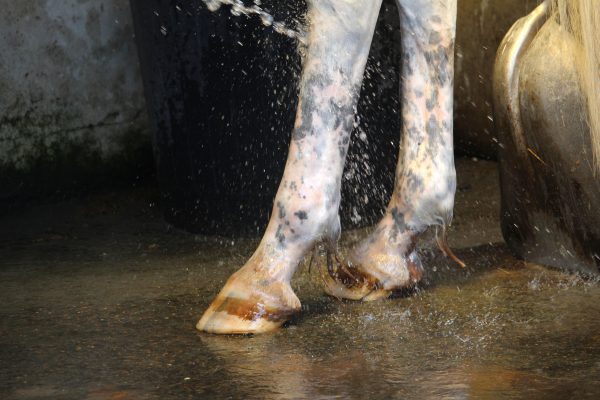|
|

If you check your horse every day, you’re sure to spot some brand-new lumps and bumps on him every once in a while. He may have been kicked while playing with his pasture mates or caught a leg in a fence. Horses can find lots of ways to hurt themselves!
So what causes swelling? In some cases, the blood vessels around an injury site expand to increase circulation. In other cases, an injury may cause lymphatic or blood vessels to leak fluid into surrounding tissues causing the area to swell.
If a bump or swelling is really big, it needs immediate attention before it causes permanent injury or disfigurement. Before you freak out though, take a closer look at the swelling. Stay calm. Assessing the injury will help you decide how to treat it and help you describe it to the veterinarian when you call her.
Gently brush your hand over the swelling. Does it cause your horse pain when you touch it? Is it hot? Is there a cut or scrape near the swelling? If it’s a bump on the leg, is your horse lame or refusing to put weight on the leg?
The next step is to cool the area with “cold therapy.” Cooling the tissues around the injury site constricts damaged blood vessels so they leak less and there’s less swelling. Cold therapy is the most effective if you do it within 12 or 36 hours following the injury so don’t wait—get started right away!
There are several kinds of cold therapy, so ask your vet which one she thinks you should use.
Hosing
Start off by hosing the swelling with cold water. Don’t just dribble the water on though, place your thumb over the hose end or use a nozzle attachment. A powerful stream of water actually massages the injured area and can help with healing.
Keep the hose on the swelling for 10-20 minutes and then look at the injury. If it’s still hot and painful call your vet and give her an update. You may have to repeat hosing therapy three or four times a day.
If your horse is fidgety or hates the hose, try another type of cold therapy.
A bucket of ice
If it’s a lower leg swelling, place your horse’s leg in a rubber bucket and add cold water to right above the injured area. Then, little by little, add a few pounds of ice. Keep adding ice to keep the water cool. Leave your horse’s leg in the bucket for 10-20 minutes—but no longer. Ice placed on skin for longer than 20 minutes can damage tissue.
When you take his leg out of the bucket, wait at least a half hour before repeating this therapy. You may have to give him four treatments to reduce the swelling. Remember to call your vet to let her know how you are getting on.
Ice boots
Ice boots are ideal for lower leg injuries. You can buy them at the tack shop or out of a catalog. These are boots that come with their own ice packets. Keep the ice packets in the freezer at all times—you never know when you’ll need them. You place the ice packets into slots in the boot and then fasten the boot on the injured leg. Leave it on for 10-20 minutes and then re-check the leg.
Icy bandages
If you don’t have an ice boot, wrap a lower leg injury with absorbent padding then loosely wrap it with a standing bandage or polo wrap. Then pour ice water over the top of the padding so it soaks the entire wrap. Rewet the wrap with ice water every few minutes.
A packet of peas
Frozen veggies are a great way to apply cold therapy to a swelling. Because peas and corn are small, the bag will conform to the shape of the injury. Wrap the bag with a towel so your hands don’t freeze and place it on the injury. Hold it in place for at least 10 minutes, and then take another look at the injury. Has the swelling gone down? If the bag has become squishy, grab another one from the freezer and hold it in place for another 10-20 minutes. You can reuse these bags over and over.
Warning: don’t eat these veggies after they’ve been used for cold therapy. Put a note on them stating: for horse use only!



